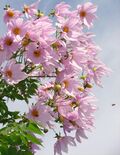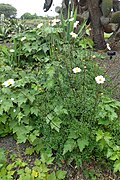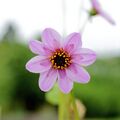Biology:List of Dahlia species
From HandWiki
Short description: none
There are 42 accepted species of flowering plants in the genus Dahlia, according to The Plant List.[1] The sectional classification of Dahlia sensu Sørensen (1969)[2] as updated by Saar et al. (2003)[3] and Hansen (2004)[4] and (2008)[5] is as follows (excluding infraspecific taxa);
Section Pseudodendron Sherff
| Image | Scientific Name | Chromosome Count | Distribution |
|---|---|---|---|
 |
D. campanulata Saar, Sørensen, & Hjerting | 2n = 32 | Mexico (Guerrero and Oaxaca) |
 |
D. excelsa Bentham | 2n = 32 | Mexico |
 |
D. imperialis Rozel ex Ortgies | 2n = 32 | Mexico, Belize, Guatemala, Honduras, El Salvador, Nicaragua, Costa Rica, Panama and south into Colombia and Ecuador |
 |
D. tenuicaulis Sørensen | 2n = 32 | Mexico (Oaxaca, Jalisco, Michoacan) |
Section Entemophyllon Sørensen
| Image | Scientific Name | Chromosome Count | Distribution |
|---|---|---|---|
| D. congestifolia Sørensen | 2n = 34[6] | Mexico (Hidalgo) | |
 |
D. dissecta S. Watson | 2n = 34 | Mexico (Tamaulipas) |
| D. foeniculifolia Sherff | 2n = 34 | Mexico (Nuevo León, Tamaulipas) | |
| D. linearis Sherff | 2n = 34 | Mexico ( Guanajuato, Querétaro) | |
| D. rupicola Sørensen | 2n = 34 | Mexico (Durango) | |
| D. scapigeroides Sherff | 2n = 34[6] | Mexico (Guanajuato, Hidalgo, Querétaro) | |
| D. sublignosa (Sørensen) Saar & Sørensen[7][8] | 2n = 34 | Mexico (Tamaulipas) |
Section Dahlia Sherff
| Subsection | Image | Scientific Name | Chromosome Count | Distribution |
|---|---|---|---|---|
| Subsection Dahlia | D. apiculata (Sherff) Sørensen | 2n = 32[6] | Mexico (Oaxaca, Puebla ) | |
| D. atropurpurea Sørensen | 2n = 64[6] | Mexico (Guerrero) | ||
| D. australis (Sherff) Sørensen | 2n = 32 or 64[6] | Mexico (Chiapas, Oaxaca, Michoacan), Guatemala | ||
| D. barkeriae Knowles and Westcott | 2n = 64[6] | Mexico (Jalisco, Michoacán) | ||
| D. brevis Sørensen | 2n = 32[6] | |||
 |
D. coccinea Cavanilles | 2n = 32 or 64[6] | Mexico | |
| D. cordifolia (Sessé & Moc.) McVaugh | 2n = 32[6] | Mexico (Michoacán) | ||
| D. cuspidata Saar, Sørensen, & Hjerting | Mexico (Guerrero ) | |||
| D. hintonii Sherff | Mexico (Guerrero ) | |||
| D. hjertingii Hansen and Sørensen | Mexico (Hidalgo) | |||
| D. mollis Sørensen | 2n = 32[6] | Mexico (Hidalgo, Guanajuato, Querétaro) | ||
| D. moorei Sherff | Mexico (Hidalgo, Querétaro) | |||
| D. neglecta Saar | Mexico Hidalgo, Guanajuato, Querétaro, Veracruz) | |||
| D. parvibracteata Saar & Sørensen | Mexico ( Jalisco) | |||
| D. pteropoda Sherff | 2n = 64[6] | Mexico ( Puebla, Oaxaca) | ||
| D. purpusii Brandg. | Mexico (Chiapas) | |||
| D. rudis Sørensen | 2n = 32 | Mexico (Distrito Federal, México, Michoacán) | ||
 |
D. sherffii Sørensen | 2n = 32 or 64[6] | Mexico (Chihuahua, Durango, Sinaloa, Jalisco) | |
| D. scapigera (A. Dietrich) Knowles & Westcott | 2n = 32[6] | Mexico (Distrito Federal, Michoacán, Guanajuato, Hidalgo) | ||
| D. sorensenii Hansen & Hjerting | 2n = 64[6] | Mexico (Distrito Federal, Michoacán, Hidalgo) | ||
| D. spectabilis Saar, Sørensen, & Hjerting | Mexico (San Luis PotosÍ) | |||
| D. tamaulipana J.Reyes, Islas & Art.Castro | 2n = 32[9] | Mexico (Tamaulipas) | ||
| D. tenuis Robinson & Greenman | 2n = 32[6] | Mexico (Oaxaca) | ||
| D. tubulata Sørensen | 2n = 32[6] | Mexico (Nuevo León, Tamaulipas, Coahuila) | ||
| D. wixarika Art.Castro, Carr.-Ortiz & Aarón Rodr. | Mexico (Durango, Jalisco) | |||
| Subsection Merckii Sørensen |  |
D. merckii Lehm. | 2n = 36[6] | Mexico ( Monterrey, Puebla, Nuevo León, Oaxaca) |
Section Epiphytum Sherff
| Image | Scientific Name | Chromosome Count | Distribution |
|---|---|---|---|
| D. macdougallii Sherff | 2n = 32 | Mexico (Oaxaca) |
Unresolved
- D. pinnata Type (more properly D. × pinnata)[10] Most likely (= D. coccinea × D. sorensenii).[4]
- D. mixtecana J. Reyes, Islas & Art.Castro (possibly Section Dahlia or Section Entemophyllon)[11]
See also
References
- ↑ The Plant List
- ↑ Sørensen, P. D. 1969. Revision of the genus Dahlia (Compositae, Heliantheae-Coreopsidinae). Rhodora 71: 309-365, 367-416.
- ↑ Dayle E. Saar, Neil O. Polans and Paul D. Sørensen. A Phylogenetic Analysis of the Genus Dahlia (Asteraceae) Based on Internal and External Transcribed Spacer Regions of Nuclear Ribosomal DNA. Systematic Botany Vol. 28, No. 3 (Jul. - Sep., 2003), pp. 627-639. Stable URL: https://www.jstor.org/stable/25063902
- ↑ 4.0 4.1 Hansen, H. V. (2004), Simplified keys to four sections with 34 species in the genus Dahlia (Asteraceae-Coreopsideae). Nordic Journal of Botany, 24: 549–553. doi: 10.1111/j.1756-1051.2004.tb01639.x
- ↑ Hans V. Hansen. Native (wild) Dahlias – taxonomy, historical review, and the derivation of cultivars, in Trial of Dahlia 2008, Final Report. Royal Horticultural Society
- ↑ 6.00 6.01 6.02 6.03 6.04 6.05 6.06 6.07 6.08 6.09 6.10 6.11 6.12 6.13 6.14 6.15 6.16 Schie, Stephan; Debener, Thomas (2013-02-05). "The generation of novel species hybrids between garden dahlias andDahlia macdougalliito increase the gene pool for variety breeding". Plant Breeding (Wiley) 132 (2): 224–228. doi:10.1111/pbr.12034. ISSN 0179-9541.
- ↑ Dayle E. Saar and Paul D. Sørensen. SIDA, Contributions to Botany Vol. 21, No. 4 (21 December 2005), pp. 2161-2167
- ↑ Elevated from D. dissecta var. sublignosa but still listed as unresolved in The Plant List
- ↑ REYES-SANTIAGO, JERÓNIMO; ISLAS-LUNA, MARÍA DE LOS ÁNGELES; MACÍAS-FLORES, RAFAEL GUADALUPE; CASTRO-CASTRO, ARTURO (2018-05-15). "Dahlia tamaulipana (Asteraceae, Coreopsideae), a new species from the Sierra Madre Oriental biogeographic province in Mexico". Phytotaxa (Magnolia Press) 349 (3): 214. doi:10.11646/phytotaxa.349.3.2. ISSN 1179-3163.
- ↑ Accepted name in The Plant List, but was not accepted by Saar (2003). Hansen, H. V. and J. P. Hierting. 1996. Observations on chromosome numbers and biosystematics in Dahlia (Asteraceae, Heliantheae) with an account on the identity of D. pinnata, D.rosea and D. coccinea. Nordic Journal of Botany 16: 445-455.
- ↑ Castro-Castro, Arturo; Munguía-Lino, Guadalupe; Islas-Luna, María De Los Ángeles; Reyes-Santiago, Jerónimo (2019-03-01). "Dahlia mixtecana (Asteraceae, Coreopsideae), a striking new species from Oaxaca, Mexico" (in en). Phytotaxa 394 (3): 209–218. doi:10.11646/phytotaxa.394.3.2. ISSN 1179-3163.
 |

